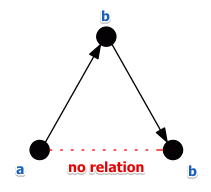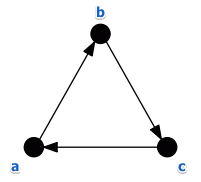Voting Theory Exercises
- Exercises: [https://www.dropbox.com/s/lfu7jt16n99pmyj/session-01-voting%20theory.pdf]
- Solutions: [https://www.dropbox.com/s/69u5we1cuux1z67/session-01-voting%20theory%20solutions.pdf]
- Used Notation: Voting Theory Relations
Exercise 4
- $N = 10$, $A$ - set of candidates
- define a relation $a \ B \ b$ as “$a$ is better than $b$”
- if this relation transitive and can it have cycles?
Exercise 4.1
Define $a \ B \ b$ as
- $a \ B \ b \iff n_{ab} \geqslant 6$ where $n_{ab}$ is the number of people who rank $a$ before $b$ (like in Condorcet’s Rule)
This voting system is very similar to the Condorcet’s Rule
We can show that it means to be transitive:
- ex-transitivity.png
- i.e. if there exists a loop then there can be no transitivity
- so it suffices to show that there can be cycles and it will answer both questions
Consider the following ranking:
- $3: a > b > c$
- $3: b > c > a$
- $4: c > a > b$
Now calculate the $B$ relationship:
- $a \ B \ b$ since $n_{ab} = 7$
- $b \ B \ c$ since $n_{bc} = 6$
- $c \ B \ a$ since $n_{ca} = 7$
We have a cycle:
Exercise 4.1
Define $a \ B \ b$ as
- $a \ B \ b \iff n_{ab} \geqslant 7$ where $n_{ab}$ is the number of people who rank $a$ before $b$
In this case $B$ also is not always transitive.
Consider the following example:
- $4: a > b > c$
- $3: b > c > a$
- $3: c > a > b$
- in this case there are not enough votes to have an edge $c \to a$

- note that his shows that the relation $B$ is not complete (this can also be the case for the previous exercise)
And there can be no cycles: too few voters for this
- consider the case with 3 candidates: $A = {a, b, c}$
-
there are 6 possible individual rankings for elements from $A$: there are 3 permutations of $A$ - $R_1: a < b < c$ – $n_1$ voters - $R_2: a < c < b$ – $n_2$ voters - $R_3: b < a < b$ – $n_3$ voters
- $R_4: b < c < a$ – $n_4$ voters
- $R_5: c < a < b$ – $n_5$ voters
- $R_6: c < b < a$ – $n_6$ voters
- $n_i$ - the number of voters with ranking $R_i$
- to have a cycle we need to have:
- $n_{ab} = n_1 + n_2 + n_6 \geqslant 7$
- $n_{ba} = n_1 + n_3 + n_4 \geqslant 7$
- $n_{ca} = n_4 + n_5 + n_6 \geqslant 7$
- let’s sum up these
- $2 \cdot n_1 + n_2 + n_3 + 2 \cdot n_4 + n_5 + 2 \cdot n_6 \geqslant 21$ (1)
- recall that we have only 10 voters:
- $n_1 + n_2 + n_3 + n_4 + n_5 + n_6 = 10$ (2)
- now let’s calculate (1) - (2):
- $n_1 + n_4 + n_6 \geqslant 11$
- this cannot happen: we have only 10 voters
- contradiction
